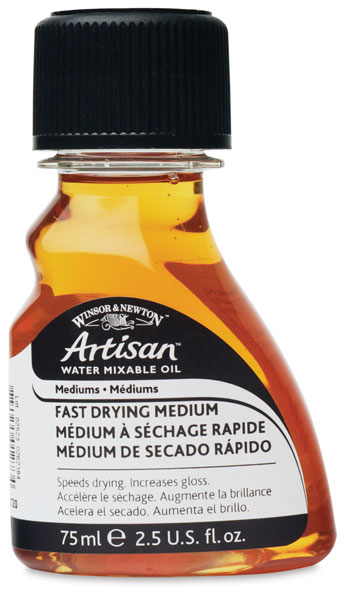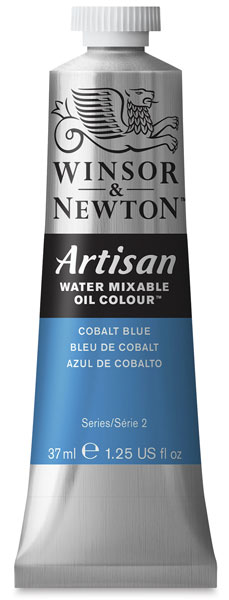By now, it’s likely you have heard of water mixable oil paint. And even if you haven’t, I’m guessing you would like to find out more about it and do not enjoy the thought of using solvents to paint with or clean the brushes.
If so, I can relate because although I loved oil painting using traditional oil paints for a few years, I just really disliked (and was worried about) working with toxic solvents. In this post, I will share how you can enjoy oil painting without a solvent by using water mixable oil paint.
This article contains product links for your convenience. They are affiliate links – click here for explanation.
Traditional Oils and Solvents
The first painting I ever did was an oil painting, and I quickly became

Many people believe that oils require the use of solvents. It’s true that a solvent helps thin the viscosity of paint and make it flow nicely as you paint.
Therefore, some oil painters will use solvents such as turpentine, turpenoid, mineral spirits, odorless paint thinner, and the like to thin the paint and clean the brushes with them.
Toxicity Can Be a Concern
But the issue is that solvents are all toxic to one degree or other. Their fumes (even the odorless solvents) are toxic if you breathe them in, get them on your skin, or accidentally ingest them (seems crazy, I know, but if you eat your lunch and paint at the same time, it could happen!). Not to mention, it really is complicated and time-consuming to use solvents—using, storing, disposal, safety/fire hazard concerns, etc.
Still, many painters successfully use solvents and minimize the exposure to their toxins by applying common sense— opening a window when

And I’m sure many are diligent about safely storing and disposing of solvent-soaked rags and containers. But in my opinion, there is room for human error, and therefore, there is still a risk (and worry). I prefer not to take that risk or have that worry—just saying.
Best Kept Secret
It is probably one of the best kept secrets that in reality, you do not have to use solvents at all to paint with traditional oils. Instead, you could just use linseed oil to help the paint glide better and master brush cleaner or even baby oil to clean the brushes.
But since this is a post about water mixable oils, here is what you need to know:
So What is Water Mixable Oil Paint?

Thus, this is a medium that is not water-based but is water-soluble for solvent-free painting. These paints are also sometimes called water-miscible as well.
They are real oil paints but are special in that you can thin them and clean up your brushes with just water. When you’re painting with them, it would be hard to tell the difference between them and traditional oils. Once dry, you cannot reactivate them with water.
Many Advantages to Using Water Mixable Oils
Why are they great? For starters, they perform like conventional oil colors. You can use all your oil painting techniques with these oils the same as regular oils. I did. Check out my oil painting here done with these paints.

(from my gallery, elainerittlerart.com)
Characteristics
They dry faster than traditional oils but still allow for plenty of time to work with them on the canvas. Really they are a happy medium (no pun intended) for those who don’t like how fast acrylics dry and but also don’t like how long it takes for conventional oils to dry.
These truly can be thinned with just a little water, which will maximize the flow of the paint.
If you thin the paint with water, then notice that the paint becomes slightly lighter when you apply it to the canvas, there’s a reason for that. Since light refracts off water differently than other surfaces, the light going through the water will make the paint appear a little lighter at first. But not to worry! It’s hardly noticeable, and the paint will return to the true color in a week or so after the water evaporates.
The only “fumes” would be the linseed oil (not toxic) in the paint. (If you don’t like that smell, then I wouldn’t recommend these paints as they smell the same as regular oils.)
If you prefer, there are compatible oil painting mediums to help the flow of the paint. (I never have used the mediums, I’m quite satisfied with just using water.)
Clean Up Is a Breeze
You can clean your brushes with water alone, which is time-saving, less messy, and a lot safer than having to clean with a solvent. This is optional, but I like to use Murphy’s Oil Soap mixed with water to clean my brushes.
I simply wet the brush, dip the bristles into a little soap, and scrub the brush working it into a lather into the palm of my hand. I repeat until it’s clean. This cleans them well and leaves the brushes conditioned.
Note: I did watch a video on cleaning brushes used with conventional oil paint using just baby oil (no solvents). Although it works, it seemed very time-consuming and laborious.
Other Pluses
If you are a plein air painter, these are so convenient—you won’t have to lug solvents around. And they are much safer in that respect, I might add.
These are great to use in a group or a classroom since no one is bothered by solvents.
These paints would be especially great for beginner oil painters since the process of painting and clean up with them is simpler using just water.

Watercolor artists who would like to try oils would have an easy transition into using these water mixable oils because the “thinner” is just water as they are accustomed to.
After I made the switch to these water mixable paints, I realized they were the perfect solution to my dilemma of loving oils but wanting to get away from the chemicals. They also greatly simplified how I paint. And I’m all about keeping it simple if you haven’t already guessed that. 🙂
My Go-to Brand
Likewise, in comparing my paintings done in water mixable oil to those in traditional oil, I did not notice any difference between them.
Windsor & Newton Artisan Water Mixable Oil Paint comes in 40 beautiful colors which are every bit as vibrant as traditional oils. Also, they are delightful to work with, having a soft but thick, smooth consistency.
How to Work with Water Mixable Oils
Working with these paints is really easy. You can thin them with water just as you would thin conventional oils with a solvent.
I simply dip my brush into a little water, then I like to blot it so it’s not dripping before going into the paint. (Only use just enough to get the paint to flow.)

This paint flows very nicely. I really do not notice any difference in the performance of these paints compared to their traditional counterpart.
You can also use an oil medium, in lieu of water, to make the paint flow if you prefer. I’ll discuss that in the next section.
But just as with any means you may use to thin, you don’t want to use too much water so that it changes the integrity of the paint and causes the pigment to separate, which in turn can cause the painting to crack.
Other Compatible Products
Brushes – Hog hair or traditional oil brushes will not work well with water mixable paint since they don’t work well with water. Instead, with these paints you should use synthetic brushes—they hold water and retain their shape.
![]()
![]()
Mediums – Winsor & Newton offers Water Mixable Oil Painting Medium, should you desire to use 
Varnishes – Winsor & Newton also offers 3 different varnishes compatible with their water mixable paints. They come in Matte, satin and gloss.
Painting Simply

Honestly, I haven’t used mediums or varnishes in my work and they’ve held up just fine. The originals of my paintings included in this post date back several years and look just as good as the day I finished painting them.
This is a true testament and proof enough for me that choosing to paint simply—solvent and medium free—and with water mixable oil paints works well and stands the true test of time!
I completed this painting on the left over 20 years ago.
Two Thumbs Up for Water Mixable Oils
I highly recommend you give water mixable oil paint a try and enjoy painting without a solvent. I know you’ll be glad you did.
There are other brands, of course, besides Winsor & Newton, that you can try. However, I’ve had tremendous satisfaction with the way Winsor & Newton performs, so I’m sticking with them.
Thanks for stopping by to read this post. Comments and questions are always welcome, and your email will never be shared!
Happy painting!
Elaine




thanks for the info.
Thank you for all of your wonderful info on this topic. I haven’t even started yet…I have the Windsor & Newton paints, but reading your info will lead me to try them very soon now. Thanks again, Sharon
You’re so welcome, Sharon. Thanks for kind words. I’m glad you’re going to give the paints a try. Happy painting!